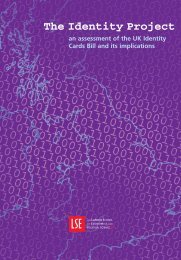Money Laundering: Review of the Reporting ... - Dematerialised ID
Money Laundering: Review of the Reporting ... - Dematerialised ID
Money Laundering: Review of the Reporting ... - Dematerialised ID
Create successful ePaper yourself
Turn your PDF publications into a flip-book with our unique Google optimized e-Paper software.
kpmg<br />
<strong>Review</strong> <strong>of</strong> <strong>the</strong> regime for handling Suspicious Activity Reports<br />
Report <strong>of</strong> recommendations<br />
KPMG LLP<br />
for 24 <strong>of</strong> <strong>the</strong> 29. Four <strong>of</strong> <strong>the</strong> five which were identified are currently being used in money<br />
laundering investigations.<br />
4.7.7 36 <strong>of</strong> <strong>the</strong> 158 SARs where it is known that investigation by an LEA was completed led to<br />
a successful outcome, with <strong>the</strong> remaining 122 identified as being intelligence only. 18 <strong>of</strong><br />
<strong>the</strong>se were cash seizures where <strong>the</strong> relevant LEA actively used its powers when PoCA<br />
came into force in late 2002 in relation to <strong>the</strong> intelligence obtained from <strong>the</strong> SARs dating<br />
from <strong>the</strong> first half <strong>of</strong> 2002, which emphasises <strong>the</strong> potential benefit that can be derived<br />
from <strong>the</strong> combination <strong>of</strong> SAR intelligence and <strong>the</strong> powers available through PoCA.<br />
4.7.8 The variety <strong>of</strong> o<strong>the</strong>r successful outcomes evident from <strong>the</strong> sample (relating to an advance<br />
fee and o<strong>the</strong>r fraud, excise <strong>of</strong>fences, money laundering, illegal immigration and share<br />
ramping) highlight <strong>the</strong> range <strong>of</strong> uses to which <strong>the</strong> information on SARs can be and are put<br />
by LEAs.<br />
Aims and focus <strong>of</strong> LEA activities<br />
4.7.9 Responses from <strong>the</strong> 53 LEAs which replied to our survey revealed a variety <strong>of</strong><br />
assumptions about <strong>the</strong> aims <strong>of</strong> <strong>the</strong> SAR regime and in consequence <strong>of</strong> that a difference <strong>of</strong><br />
focus and attention given to <strong>the</strong> SARs which are disseminated to <strong>the</strong>m. We asked LEAs<br />
in our survey what <strong>the</strong>y considered to be <strong>the</strong> main aim <strong>of</strong> <strong>the</strong> SAR regime. We received a<br />
variety <strong>of</strong> responses and have identified <strong>the</strong> main <strong>the</strong>mes from <strong>the</strong> multiple answers given<br />
as follows:<br />
• 14 made specific mention <strong>of</strong> intelligence.<br />
• 32 referred to <strong>the</strong> detection and investigation <strong>of</strong> crime (or <strong>the</strong> proceeds <strong>of</strong> crime) in<br />
general, and six <strong>of</strong> <strong>the</strong>se also mentioned <strong>the</strong> detection and investigation <strong>of</strong> money<br />
laundering.<br />
• Six mentioned <strong>the</strong> detection and/or investigation <strong>of</strong> money laundering only.<br />
• Two specifically mentioned <strong>the</strong> disruption <strong>of</strong> crime.<br />
Resource levels at individual LEAs<br />
4.7.10 The total number <strong>of</strong> staff in <strong>the</strong> 57 LEAs dealing with SARs (as recorded in response to<br />
our questionnaire) was approximately 500, although most <strong>of</strong> <strong>the</strong>se individuals will only<br />
dedicate a relatively small proportion <strong>of</strong> <strong>the</strong>ir time to dealing with SARs. Some 300 <strong>of</strong><br />
<strong>the</strong>se relate to HMC&E staff, (who HMC&E informed us, will spend an average <strong>of</strong> 15%<br />
<strong>of</strong> <strong>the</strong>ir time on SARs) leaving around 200 staff spread across <strong>the</strong> o<strong>the</strong>r 52 LEAs. It<br />
should be noted that <strong>the</strong>se include all staff dealing with financial crime (not solely related<br />
to <strong>of</strong>fences linked to SARs), and <strong>the</strong> more focused LEAs such as <strong>the</strong> Metropolitan Police<br />
and City <strong>of</strong> London Police who dedicate a relatively larger number <strong>of</strong> staff to<br />
investigating SAR related potential crimes. KPMG’s calculation on <strong>the</strong> basis <strong>of</strong> <strong>the</strong><br />
figures provided to us is that <strong>the</strong>re were 157 “effective full-time staff” at <strong>the</strong> time <strong>of</strong> our<br />
survey earlier this year but that <strong>the</strong>re was a variation in <strong>the</strong> priority attached to SARs<br />
across LEAs.<br />
jo/fh/519 46









